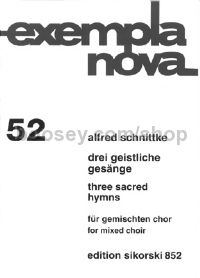3 Geistliche Gesange (Piano Reduction)
3 Geistliche Gesange (Piano Reduction)
Bulk Discounts Available
* Estimated price converted from UK retail price
Der Dirigent Valery Polyansky berichtet, wie er, nachdem er 1983 in Moskau Schnittkes Faust-Kantate dirigiert hatte, den Komponisten gebeten habe, etwas für ihn und seinen Chor zu schreiben. Zuerst war Schnittke nicht bereit dazu. Irgendwann trafen sich Komponist und Dirigent dann im Puschkin-Museum wieder und Polyansky wiederholte seine Bitte. Gleich am nächsten Tag sei Schnittke auf den Dirigenten zugegangen, habe ihn einen „schrecklichen Kerl“ genannt und ihm das Manuskript der „Drei geistlichen Gesänge“ in die Hand gedrückt. Schnittke war offenbar mitten in der Nacht aufgewacht und hatte sie komponiert!
Anfangs hatte er vorgehabt, die gesamte, aus sechs oder sieben Stücken bestehende traditionelle russisch-orthodoxe Andacht zu vertonen. Doch Schnittke stellte damals gerade Überlegungen bezüglich der Vertonung von Texten Gregor Narekatsis an, einem armenischen Mönch und Dichter des zehnten Jahrhunderts, - was in der Entstehung des Chorkonzerts Ausdruck finden sollte. Daher schrieb er Musik nur für drei Gebete, die im Zentrum des russisch-orthodoxen Glaubens stehen.
---------------------------------------------------------
The 'Three Sacred Hymns' were composed in 1983. The Russian conductor Valery Polyansky had requested an a cappella work for his choir, and though at first Schnittke seemed reluctant, he apparently woke in the middle of the night and wrote down these three pieces, and handed the manuscript to Polyansky the following day. The work was only published posthumously.
Certain melodic figures and scale passages bind the three pieces together, as does the harmonic plan. The first piece uses the two choirs antiphonally and in strict canon, one measure apart, the first choir singing in E-flat major, the second choir a minor third lower in C minor; the second piece, a dramatic supplication rising from piano to fortissimo in a single brief arch, is in C minor; while the third piece, the most harmonically varied of the three, is in E-flat major.




